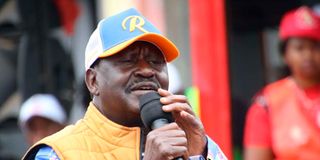Exposed: Names behind Kenya's August poll lies

Fake news operatives strive to give the impression that their preferred candidates are in the lead.
President Uhuru Kenyatta’s succession is marred by a campaign of disinformation designed to rig the presidential vote by disparaging the leading contenders William Ruto and Raila Odinga.
The fake news smear campaign is waged by operatives of the rival coalitions, who are also doctoring polls to give the impression that their preferred candidates are in the lead, and has become more pronounced in this year’s election as it is increasingly being fought online.
Like in war where truth is the first casualty, ongoing campaigns in the election of the country’s fifth president are fuelled by propaganda that could unfairly influence the outcome of the vote, if activities of British consulting firm Cambridge Analytica in past elections are anything to go by.
Years after World War I and II, stories are told about the suffering experienced by prisoners of war, and how they risked their lives in prison camps to obtain the truth about the war.
Books such as Do The Birds Still Sing In Hell? by Horace Greasley and Unbroken by Laura Hillenbrand, detail how, often within the prisoners’ earshot, soldiers spoke about how the countries where the prisoners came from were losing dismally, to discourage the prisoners and push them into giving up.
In search of the truth, Greasley explains how he, as a prisoner of war, convinced his girlfriend to smuggle radio parts for him, with which he and his friends built a radio on the ceiling that they listened to at night. The soldiers had mastered the art of propaganda, one which is defined by the Oxford Dictionary as ideas or statements that may be false or exaggerated and that are used in order to gain support for a political leader or party.
That has since evolved into an array of crafty tactics such as fake news, misinformation and disinformation. The latter is defined by the same dictionary as false information that is given deliberately, and its proliferation in this electioneering period is mind-boggling.

Azimio la Umoja presidential candidate Raila Odinga.
Credibility thrown to the dogs
Experts say that with the advent of social media, the power to spread information, which in the old times was the preserve of the military, has been handed to the people, most of whom have thrown credibility to the dogs. Now, social media users across various platforms consume and share fake news, as some leverage weaponised curated amplification techniques for political gain.
Falsehoods come in form of image distortion, wrong translation, deliberate false information online, use of wrong photos, use of automated bots and impersonation of credible companies, individuals and media organisations.
The most memorable incident on misinformation happened on May 24, when United Democratic Movement deputy presidential candidate Rigathi Gachagua stepped into Inooro Television studios for an interview. Jubilantly, he explained his party’s plans to improve small and medium enterprises, instead of empowering big and established businesses.
In 90 minutes, social media was ablaze. A 10-second video segment of his interview in his native Kikuyu language went viral on Twitter and Facebook due to deceptive English subtitles. This was complemented by several Twitter hashtags that further emphasised the narratives from the manipulated video.
The misleading English subtitles alleged that if Kenya Kwanza won the presidency, the government would shut down large corporations and distribute the proceeds as handouts. The video started a series of attacks that lasted between May 24 and May 27.
To twist the knife in the wound, a fake press statement attributed to Safaricom surfaced, indicating how irate the giant telco was with the alleged statement from Mr Gachagua. To counter this, Safaricom released a press statement that rendered the circulating letter null.
An analysis by Code for Africa shows that, as a result of the manipulated translation, two hashtags, #AKissForDo and #Mobitelea trended on Twitter between May 25 and 27 to promote narratives characterising Mr Gachagua as a dishonest politician.
Anti-Gachagua narratives spread rapidly, with the first disinformation incident occurring within four minutes on Twitter and in 10 minutes on Facebook. The video with misleading subtitles surfaced less than two hours after the statement was made.
According to the research, various techniques were used to misinform and amplify the message, including a combination of false captions on a video, screenshots, as well as showing fake credibility by using a fake letter. To amplify the disinformation, some accounts copy-pasted the content and spread it.
To analyse the data, Meltwater, a social media monitoring and analysis tool, was used to collect tweets with the following set of keywords; (“rigathi” or “gachagua” or “Rigathi Gachagua” ) and (“Safaricom”) from May 24 to 25, to investigate the issues, traits, narratives, and actors who spearheaded this conversation that spawned from the TV interview.
The results showed that there were a total of 4,730 mentions, with an average of 2,360 mentions a day. The top retweeted account, with 403 tweets, was @disembe, which had three tweets related to Rigathi and Safaricom. @Belive_kinuthia, with 388 tweets, had the second highest number of retweets.

Kenya Kwanza presidential candidate William Ruto
Artificial amplification check
To check for the potential artificial amplification of the Rigathi-Safaricom disinformation campaign, the analysis looked into the accounts with the highest number of tweets containing this combination of words. Two of the top five accounts involved in tweeting and quoting Rigathi and Safaricom had a higher metric of 4 out of 5. This is an indicator that the activities of these accounts might have been automated (using bots).
A network analysis of Facebook posts made regarding Mr Rigathi Gachagua and Safaricom showed a different approach to disinformation from that on Twitter. Unlike Twitter, where individual accounts drove the conversation, Facebook groups and pages controlled the conversation. Within 48 hours, 478 posts had been made with 122,712 interactions. The use of groups and pages showed a higher reach than Twitter.
Social media impersonators are also on the rise, as they create accounts with politicians’ names and use them to spread fake news.
Examples of such include the Hon Moses M Wetang’ula account on Facebook, which was created in March 2022. The senator’s name has a slew of accounts, some of which post bizarre content. Others have mastered the art of changing names while Photoshop creatives are also working overtime.
An example is the widely shared photo showing a woman dressed in a green top and blue jeans standing outside a seemingly old building, with the face of Martha Karua, the running mate of Azimio One Kenya Alliance presidential candidate Raila Odinga.

Azimio la Umoja coalition running mate Martha Karua.
Photo modified
Our investigation revealed that the photo had been modified. The original photo belonged to another woman, likely from a different country, because the architecture portrayed in the photo is not common in Kenya.
Mr Odinga’s launch of his manifesto was likewise overshadowed by a statement he made about mitumba that rivals capitalised on to portray him as insensitive to informal traders. So effective was the propaganda — that he is anti-small businesses — that he had to host representatives of second-hand clothes dealers for a meeting to explain his plan for the industry should he succeed to form the next government.
Then there was a doctored video that gave the impression that former US President Barrack Obama had endorsed Dr Ruto’s presidential candidature; except the fact that the widely shared video of Mr Obama purportedly unveiling a large image of his preferred candidate had been doctored had actually unveiled a portrait of himself in Washington, DC in 2018.
A fake poll also trended in June, showing Prof George Wajackoyah, the presidential candidate and party leader of the Roots Party, as the most preferred presidential candidate. The results were purported to have originated from Citizen TV but were flagged by the media house as fake.
When the fake degrees saga for election candidates arose, a fake certificate of completion from a foreign university, purported to belong to Mr Odinga, also surfaced.
His allies and supporters shared it widely, each having something to say over an online paper whose credibility cannot be accounted for.

Kenya Kwanza coalition running mate Rigathi Gachagua.
Go hand in hand
Political analyst Herman Manyora told the Nation that propaganda and disinformation strategies go hand in hand. While he refers to propaganda as telling untrue things in order to misinform people, he refers to disinformation as deliberately giving someone wrong information.
Even the Church had a propaganda ministry centuries ago, he said, which enabled it to propagate the word of God, and that only in the 20th century did the word ‘propaganda’ acquire a new meaning.
“People who spread disinformation do so by appealing to authorities. They tell their people: ‘Uhuru has said, Raila has said’, so that they are able to believe them easily.
Other techniques include attacking people personally, exaggeration, misplacing truth and spreading myths to make yourself seem unbeatable,” he explained.
Continuously give information
Disinformation, said the analyst, thrives when agencies that are supposed to give information to the public are silent.
“Agencies like IEBC should continuously give information. They should regularly update the public about any new things they do instead of saying one thing and disappearing. They should give the true position, share information, and engage citizens all the time to reduce fears and reduce sharing of fake news,” he said.
Asked whether social media wars can translate to physical violence, Mr Manyora said: “Radio caused genocide in Rwanda.”
He explained that propaganda and disinformation, when used well, can succeed in swaying voters to the opposite side. And it doesn’t always have to be about spreading fake news. Sometimes politicians can use facts, but apply them selectively in instances that can lead to disinformation.
Mr Wilson Muirani Gathoni, the head of media at Roots Party, says the use of propaganda as a political tool in the country has only escalated now because of the upcoming elections. Some political parties, says Mr Gathoni, started spreading them three years ago to shape people’s minds so that they become popular.
Unite the country
Like Mr Manyora, he agrees that disinformation that spreads tension and hate has the possibility of dividing a country. As a result, winning candidates have to spend their first few months in the presidency trying to unite the country, which would otherwise be spent in executing their manifestos.
“Kenyans are not divided. The people who create those divisions while advancing their agenda are politicians. They craft messages, making lies appear as truths,” said Gathoni.
“A while back, Central Kenya would not vote for ODM leader Raila Odinga because politicians told them that Raila is a bad person who didn’t deserve a chance. But so that you realise that Kenyans were not the problem, the same politicians are going back there to say he is the best person that can be trusted to lead the nation. But it’s only because it fits their political interests,” he stated.
Despite always being on the lookout, he said the party had encountered fake news targeted against its candidate, Wajackoyah. Some people have created fake social media accounts in the name of Wajackoyah, whose content has been consumed and believed by some Kenyans.
“Those accounts run the risk of communicating messages that do not come from us. We have reported them. However, we cannot keep all our energies there. We focus on clarifying issues to counter them. We ensure that our information is consistent, to put off those who want to spin the message. I want to urge Kenyans to read and verify information to avoid spreading fake news and mudslinging of candidates,” said Gathoni.






